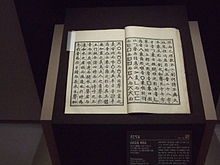Hunminjeongeum Haerye
This article includes a list of references, related reading, or external links, but its sources remain unclear because it lacks inline citations. (January 2014) |
| Hunminjeongeum Haerye | |
 Hunminjeongeum Haerye uses right-to-left vertical writing. Here it explains the shapes of the basic consonants. | |
| Korean name | |
|---|---|
| Hangul | 훈민정음 해례 |
| Hanja | 訓民正音解例 |
| Revised Romanization | Hunminjeong(-)eum Haerye |
| McCune–Reischauer | Hunminjŏngŭm Haerye |
Hunminjeongeum Haerye (lit. "Explanations and Examples of the Correct/Proper Sounds for the Instruction of the People"), also called the Haerye Edition of Hunminjeongeum or simply The Haerye, is a commentary on the Hunminjeongeum, the original promulgation of hangul.
It was written by scholars from the Jiphyeonjeon (Hall of Worthies), commissioned by King Sejong the Great. In addition to an introduction by Sejong (excerpted from the beginning of Hunminjeongeum) and a colophon by the scholar Jeong Inji (鄭麟趾), it contains the following chapters:
- "An Explanation of the Design of the Letters" (制字解)
- "An Explanation of the Initials" (初聲解)
- "An Explanation of the Medials" (中聲解)
- "An Explanation of the Finals" (終聲解)
- "An Explanation of the Combination of the Letters" (合字解)
- "Examples of the Uses of the Letters" (用字例)
See Hangul letter design for an excerpt of the letter design explanations from chapters 2 through 4.
The original publication is 65 pages of hanja in regular script, except where hangul are mentioned and illustrated. Only one original copy exists, which was made public in 1940 by Jeon Hyeongpil, an antique collector who acquired it from Lee Hangeol (1880–1950), whose family had possessed it for generations.
Now kept in the Kansong Art Museum (간송 미술관; 澗松美術館), it is South Korean National Treasure number 70 and has been a UNESCO Memory of the World Register since October 1997.
See also
- List of Korea-related topics
- Sejong Professor of Korean History Emeritus at Columbia University, Gari Ledyard traces five consonants credited in the manuscript to the Gu Seal Script of the Mongol Yuan dynasty to similar sounding Indoeuropean consonants linking the Greek, Latin and Syriac alphabets of the West to the Phagspa/Tibetan scripts of the East
External links
- Entire publication typed up in hanja and translation in Japanese
- Entire document scanned: translation available in German
